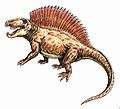Ctenospondylus
| Ctenospondylus | |
|---|---|
 | |
| Ctenospondylus casei from the Early Permian of North America | |
| Scientific classification | |
| Kingdom: | Animalia |
| Phylum: | Chordata |
| Family: | †Sphenacodontidae |
| Subfamily: | †Sphenacodontinae |
| Genus: | †Ctenospondylus |
| Species | |
| |
Ctenospondylus ("comb vertebra") is an extinct genus of pelycosaurs. Species were about 3 meters (10 feet) long. The genus is known only from the 'Seymouran' Land Vertebrate Faunachron, which is equivalent to the upper part of the Artinskian stage and the lowermost Kungurian stage of the Early Permian.[1] Its fossils were found in the U.S. states of Ohio and Texas. It was a carnivore and preyed upon animals close to its size. Ctenospondylus had a long tail, short back spines, and a very deep yet narrow skull with massive jaws that had sharp teeth. Because of its large size, it was probably the apex predator in its environment, and might have competed with other predators like Dimetrodon for food. A Sphenacodontid, it was a close relative of Dimetrodon.
Gallery
See also
References
- ↑ Lucas, S.G. (2006). "Global Permian tetrapod biostratigraphy and biochronology". In Lucas S.G.; Cassinis G.; Schneider J.W. Non-Marine Permian Biostratigraphy and Biochronology. Special Publications. 265. London: Geological Society. pp. 65–93. ISBN 9781862392069. Retrieved 10 December 2012.

